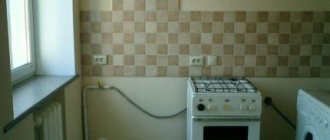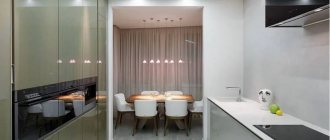Moving a kitchen into a living room is a difficult process, but possible. Such redevelopment can make living more comfortable by combining rooms and allocating an additional room.
Moving the kitchen into the room is popular not only in houses built last century, but even among homeowners in modern new buildings.
The main obstacle to achieving our plans is sanitary, building codes and standards. All information about the possibility of moving the kitchen is in the documents - SanPiN 2.1.2.2645-10 and SNiP 31-01-2003. Any actions require approval.
Relocating a kitchen using examples of different projects and layouts, as well as important nuances, can be seen in the video:
Let's consider when such redevelopment can and cannot be carried out.
Moving the kitchen into the living room
The kitchen is the soul of the Russian home. This includes relatives, friends and neighbors. Household members gather here many times a day: they eat, communicate, exchange news, make plans, celebrate holidays, and celebrate significant dates. If the kitchen space can no longer accommodate those who want it, it becomes important to move the kitchen to the living room or a more suitable place. This article highlights the issues surrounding this difficult event. Content links will help you quickly find answers to the most pressing questions.
Content
- Relocating a kitchen from the point of view of current legislation
- Using the space of a dismantled bathroom
- Placing a kitchen in a living room
- Problems with sewerage, ventilation, lighting when moving the kitchen into an apartment
- The main obstacles to obtaining permission (legalizing the transfer)
- Conclusion
Conclusion
Relocating a kitchen is a painstaking process that requires mandatory prior approval and the participation of many specialists. During repairs, you will need to contact the BTI, the Moscow Housing Inspectorate, the management company, and sometimes Mosgaz and Mosenergo.
Before starting the redevelopment, we recommend that you contact APM-1 for a consultation so that you have a clear understanding of what stages are important not to skip and what preliminary work in the apartment needs to be done in your case, because each redevelopment is individual.
Leave a request for a free consultation on apartment redevelopment
Zamyatin Dmitry Alekseevich
Zamyatin Dmitry Alekseevich
General Director of LLC "APM-1" Design workshop PEREPLAN.
Education: Higher technical (Master's degree from Moscow State University of Civil Engineering)
Specialization Coordination of redevelopment of commercial and residential real estate in Moscow and St. Petersburg
Relocating a kitchen from the point of view of current legislation
Many of those wondering whether it is possible to move the kitchen into the living room are captured by erroneous judgments. Some believe that such a change in layout is impossible, others - that the path to obtaining permission to move the kitchen is littered with insurmountable problems, and others - that in your own privatized housing (apartment, house) any alterations are allowed, as long as there is enough space. Still others are convinced that they will be able to retroactively legitimize everything that is arbitrarily altered and transferred.
The result is numerous violations, refusals to legalize redevelopment and fines, damaged equipment, frayed nerves, shed tears, lost time and wasted funds. The above troubles can be avoided. To do this, you need to know and take into account the attitude of the legislation to changing the configuration of living space. Let us immediately note that the law allows for the redevelopment of an apartment with the relocation of the kitchen. The mandatory conditions are:
- Preservation (not deterioration) of your own living conditions and neighbors after moving the kitchen;
- Following current sanitary (SanPiN 2.1.2.2645-10) and construction (SNiP 31-03-2003) standards and regulations;
- Compliance with the procedure for obtaining permission for redevelopment and agreeing to move the kitchen to a room or another place;
- Legalization of unauthorized modification of the layout in accordance with the prescribed procedure.
To be fair, we note a number of legal reasons for moving a kitchen to a new location. Permitting procedures will be simplified as much as possible when:
- The apartment to be rebuilt is on the ground floor (no one’s living conditions and interests are affected, you can safely do the redevelopment, based on building regulations);
- The reconstruction was started by the owner or tenant of a two-level housing (the interests, sanitary and living conditions of the neighbors below are not affected);
- The kitchen area is “relocated” above the corridors, storage rooms, and other non-residential premises located on the lower floors.
During renovation work related to the placement of a kitchen space in another area, it is necessary to solve typical problems in linking the actions performed with the existing requirements of regulatory documents. These include:
- Use of space vacated as a result of demolition (liquidation) of a bathroom;
- Transfer of the kitchen itself and kitchen equipment to the living room;
- Modification of sewerage and water supply;
- Ensure proper ventilation and natural light.
We will lay out subsequent material in the same order.
Non-compliance and possible sanctions
According to the administrative code of the Russian Federation, illegal redevelopment can lead to penalties. After paying the fines, you are required to arrange for redevelopment. In case of violation of sanitary and construction standards, as well as fire safety requirements, which led to a negative impact on the condition of the residential building, you will be required to take reverse action. The apartment will need to be returned to its original condition. Refusal to comply leads to serious consequences, including loss of property rights, as specified in the Civil Code of the Russian Federation, Article 293!
Using the space of a dismantled bathroom
By law, it is prohibited to move a kitchen to the site of a bathroom or bathroom that was liquidated for this purpose. The provisions of SanPiN 2.1.2.2645-10 (clause 3.8) and SNiP 31-03-2003 (clause 9.22) prohibit placing bathrooms above living rooms and kitchen areas. The only exception is two-level apartments. According to the law, by placing a kitchen on the “territory” of a former toilet, the owners are formally worsening living conditions.
Just five years ago, the problem was solved by contacting the competent authority with a statement about the awareness of such a step and the obligation to notify the buyer about this in the event of an apartment sale. Today, this loophole in the law has been closed. Exceptions are housing on two levels or living on the top floor, excluding the presence of bathrooms for neighbors above.
Reasons for redevelopment
Changing the position of plumbing equipment is an opportunity to improve the usability of the room. Moving the washing structure to another location will allow you to obtain the most ergonomic design that will fit into the characteristics of the room and the requirements of the owners.
Reasons for the transfer Source frontlinebathrooms.co.uk
Relocating a kitchen sink is often due to financial reasons. For example, if you install plumbing equipment near a window, you can save on utility bills. The presence of daylight will eliminate the need to burn energy when washing dishes and processing food.
Moving the sink is necessary for rational use of usable space. This aspect is relevant both for tiny Khrushchev houses, studios, and for large kitchens in new buildings. You can place a set or storage area near the wall, and the plumbing equipment is removed to the window, to the opposite partition, or placed in the center.
Beautiful design Source tdstroysnab96.ru
When transferring a shell, the psychological aspect is also taken into account. In standard designs, sinks are placed in a blind corner or next to wall cabinets. Washing dishes on a separate “island” or near a window is much more pleasant than monotonously looking at a wall or furniture.
Relocating plumbing fixtures can improve kitchen ventilation. Relocating the sink will help increase air exchange in the room. Water drops dry faster, so there will be no humidity or fungus in the room.
Placing a kitchen in a living room
On January 26, 2006, the Government of the Russian Federation, by resolution No. 47 (see paragraph 22), clearly prohibited the transfer of the kitchen to the place where their own premises were located or under which residential premises were located on the lower floors. Having arbitrarily carried out such a redevelopment, the developer formally changed the status of the neighbor’s room below to “non-residential”. Such a legal conflict is unacceptable. But the law does not prohibit moving kitchen equipment to the corridor, former storage room or other non-residential premises. Placing an apartment on the ground floor or above non-residential areas also does not create restrictions for the plan.
Another unpleasant moment. If the mentioned redevelopment is successful, it will not be possible to arrange a children’s room, living room or bedroom in the vacant (former “kitchen”) space. According to the law, living rooms cannot be located under the kitchens of neighbors above. However, this situation has a legal solution. This is the design of these square meters as a work office. Legally, it will be non-residential, but it can be used at the discretion of the owner.
A few more nuances to consider:
- The newly equipped kitchen should receive natural light through an existing window or through a glass partition from the adjacent room;
- When arranging a kitchen-living room (studio), you will need to replace the gas stove with an electric one;
- Reluctance to switch from gas to electricity will result in the impossibility of making an opening from the kitchen to the living room in the partition between the rooms or the need to install a closing door (sliding partition) in it;
- When deciding to replace a stove (gas to electric), it is advisable to evaluate the increase in electricity bills.
Redevelopment of fully electrified apartments is much easier than gasified ones!
Is the neighbor a controlling “authority”?
Exactly. The housing inspectorate, the management company and even other residents have the right to initiate proceedings regarding illegal redevelopment. A statement from a vigilant neighbor to the BTI, or even the prosecutor's office, is enough for a competent inspection to come.
On a note. Based on the information received, regulatory authorities have the right to carry out an unscheduled inspection to identify and suppress violations of housing legislation. Based on the identified facts, administrative proceedings are initiated with the possible transfer of materials to the court.
It is better not to bring the situation into conflict with the law by agreeing on the upcoming work in advance.
You can learn how to properly legalize redevelopment in an apartment by watching the video:
See also Phone numbers for consultation 07 Jan 2022 kasjanenko 1185
Share this post
Discussion: 4 comments
- Ivan says:
06/08/2019 at 13:39Many transfers and redevelopments can cause security threats to other residents of this house. Are there any rules regarding criminal punishment for officials who gave permission for the reconstruction of an apartment, which then caused damage to the entire house?
Answer
- Nikolay says:
07/31/2019 at 08:23
I don’t understand, if the kitchen is gasified, then you can’t demolish the partition, but sliding panels can. What good are these sliding doors if there is a gas leak? Can they compare with a solid solid wall, of course not.
Answer
- Oleg says:
01/16/2020 at 16:09
How should a tenant act if he suspects that one of the apartments in his building is undergoing renovation work with the demolition of major partitions? Do the owners of such an apartment have a right not to let a local police officer inside if he doesn’t have a warrant?
Answer
- Anna says:
08/18/2020 at 12:13
At one time, almost half of our house, without any legalization, moved the kitchens to the loggias, breaking out the walls between the kitchen and the loggia, and then somehow some legalized it, and some still didn’t, but it seems to me that such alterations are generally prohibited . We wrote so many applications to replace the gas pipe. and here is such a change, moving the gas stove to the loggia. Why allow this at all? This is the safety of a huge house, and then houses explode from such remodelers.
Answer
Problems with sewerage, ventilation, lighting when moving the kitchen into an apartment
Now let’s look at what moving a kitchen means for house communications.
A gas stove is an obstacle to a radical change in layout. When starting a redevelopment, it is advisable to replace the gas stove with an electric one!
Sewerage and water supply
The normal functioning of the kitchen involves ensuring the supply (transfer) of all types of household communications to a new location. Building codes require that the water supply to the dishwasher and kitchen sink, as well as the disposal of used water, must be uninterrupted (unobstructed) and constant. To supply water, old cold and hot water supply pipes are extended (extended) or new ones are laid. Laying is carried out in four ways:
- Along the walls in fines;
- Under the screed;
- Under a suspended or suspended ceiling;
- In decorative wall boxes.
It is advisable to re-lay sewer pipes in old houses. This is more technologically advanced and makes it easy to eliminate the structural differences between cast iron and plastic pipes. In new buildings this problem is solved even easier. Laying under a screed, especially at a distance of more than 3-4 meters, is not possible without installing a special pump: in order for wastewater to drain naturally, it is necessary to ensure a pipe slope of 3-5 degrees (about 3 cm per 1 linear meter of sewerage).
Wiring
To ensure sufficient illumination of the working surface and dining area, the correct and safe functioning of kitchen household electrical appliances, electrical wiring should be carried out. It must match the power consumption.
Moving a kitchen without a well-thought-out wiring design (scheme), without a reasonable choice of the type, material and cross-section of current-carrying conductors is a dangerous undertaking. Improper wiring is the cause of most fires. Therefore, the design of the electrical wiring diagram and electrical installation work must be entrusted to qualified specialists. Unlike new buildings, when remodeling old houses, it is better to completely replace the electrical wiring rather than move it.
Ventilation
Those wondering “is it possible to move the kitchen?” must be aware that a new kitchen must be equipped with ventilation. In accordance with SNiP 31-3-2003 (clause 9.7), it is entrusted with the task of removing air with substances formed during the combustion of household gas. Ventilation:
- It is connected to the old (which existed before the apartment was renovated) sealed ventilation duct, which sometimes stretches through other rooms;
- It cannot intersect with the neighbors’ ventilation, nor with the one installed in the bathroom, nor connect to the latter.
The main obstacle to installing ventilation is hiding the duct. Ways to get around are suspended ceilings, decorative boxes, grooved walls (including load-bearing ones) with holes made in them. For the latter, you will need to obtain a permit. It is advisable to equip long ventilation ducts with exhaust fans. In older houses, it is sometimes necessary to clean the ventilation ducts. In new buildings there is no such problem.
Lighting
The newly equipped kitchen should have sufficient lighting. According to SNiP 05/23/2010, the lighting standard for a kitchen room is not less than 150 Lux. According to SaNPiN2.1.2.2645-10 and SP 54.13330.2016, natural light should enter it during the day. Possible paths:
- From the street through the existing window;
- Through a fiberglass door;
- From the adjacent room through a glass partition, a partition made of glass blocks.
If the kitchen is moved to one of the former residential premises, problems with wiring and natural lighting usually do not arise. The option of moving it to a non-residential premises may cause difficulties with lighting, which will not be difficult for the designers and architects of our Redevelopment Coordination Bureau “PereplanHome” to solve. At the end of the article, we will focus on barriers that can significantly complicate permitting procedures.
A few more important nuances
- Ventilation. It is required in the new premises, but moving it is the most problematic part. It is not advisable to move the kitchen if you have to pull the ventilation pipe more than 10 meters. The craving will decrease. Additional fans will be required. This is not the best idea for an apartment with a low ceiling.
It is also useful to read: Review of hoods for the kitchen without venting to the ventilation.
- Temperature conditions. Permissible temperature is 18-26 degrees Celsius. In cold weather – 19-21 degrees.
- The natural light ratio is also important. Its value is from 0.5. The new location must have sufficient lighting. It is not allowed to erect blind partitions that will block the window to the street.
- It is not recommended to carry the water supply far. This is fraught with a decrease in pressure due to the large horizontal extent. The pipes are hidden under the floor or in a drywall box.
- The cross-section of sewer pipes is larger than water pipes. Considering that they must run at a slope, the floor under which they are hidden will have to be raised. An idea for apartments with sufficient ceiling heights.
- It is worth taking into account the load of the electrical network and, if necessary, installing a separate machine.
The main obstacles to obtaining permission (legalizing the transfer)
Those who have at least once tried to obtain permission to move a kitchen, or have legalized the redevelopment when it has already been moved, know firsthand about the existence of bureaucratic obstacles. To move a kitchen into a room or other premises legally, you need to remember the following or probable:
- Deterioration of living conditions;
- Violation of the integrity of load-bearing walls;
- Unqualified intervention in electrical wiring;
- Improper modification of the water supply system;
- Unacceptable changes to the heating system;
- Miscalculations in ensuring temperature conditions.
If the housing is located above administrative buildings (shop, office, cafe, restaurant), you do not need to worry that it will be prohibited from redevelopment, since in this case the kitchen will have to be moved above non-residential premises!
How to legitimize reconstruction?
What documents need to be completed to carry out a legal kitchen remodel?
The main rule: first we agree on the project and only after receiving permission we begin work. Moreover, obtaining permission is no less difficult than carrying out the work. The algorithm includes:
- collection of documents;
- sending the prepared package for consideration by the commission of architecture and urban planning under the municipality. You will have to be patient: 30 days are allotted for the examination of upcoming work, submitted papers and making a decision;
- hiring a team of specialists and carrying out work according to the reconstruction/redevelopment plan.
Fines and liability for unauthorized removal of a slab
It is worth noting that moving a gas stove without approval is quite difficult, because licensed gas workers simply will not agree to unapproved work.
But if it works out, then you cannot avoid fines: both from the gas service and from the BTI. In addition, you may be required to cover the costs of the examination.
IMPORTANT!
Carrying out gas work yourself may cause a fire or explosion! You risk not only your safety, but also the health of others. If the fact of harm to the health of other people is proven, then punishment is possible, including criminal liability .











